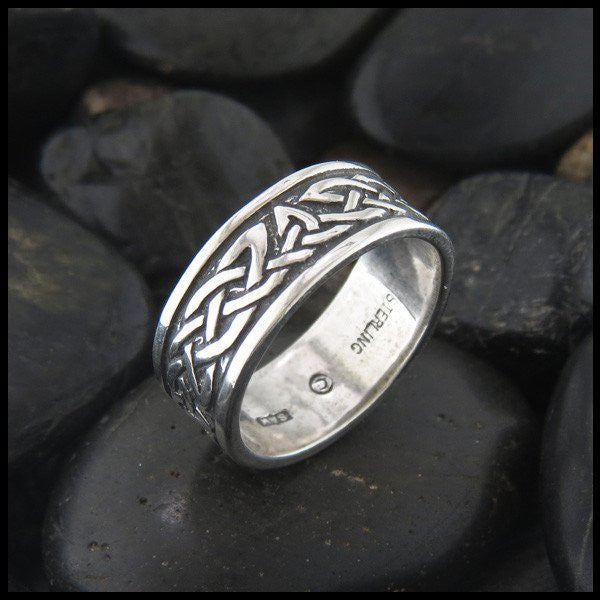- Jewelry
- Crosses
- Rings
- Mens
- Claddagh
- Wedding
- Personalized Jewelry
- John Urban Jewelry
- Sale
- Gift Certificates
- About Us

Are you shopping for a Celtic Ring, but you're unsure of your size in US ring sizes? Use the chart below for conversion of US and Canadian number sizes to the "Wheat sheaf" system of letter sizes used in Ireland, U.K. Australia, ect. Diameters and circumferences are also given in both inches and millimetres. Please note that these measurements are exact for the American system and approximate for the other sizing scales, since the intervals in each system do not correspond exactly. If you don't have any idea of size check out our article on Getting Her Ring Size Without Ruining the Surprise. The paper trick works for finding out your own size as well!
Ring sizing gauges and finger gauges as well as published charts do not always agree. Add to this that there are two conflicting methods of reading ring gauges so it is quite common for ring sizes to vary slightly from one workshop or jeweler to another. The ring sizing information presented here is the result of a conscientious study and comparison of various sources and is consistent with the instruments and measuring technique that we use in our workshop.
Reality Check
Rings and gauges are hard metal objects that can be measured exactly, but your finger is flesh and bone. Your finger is not round and it cannot be measured with the same degree of accuracy as the ring. At the end of the day, the right ring is one that will stay on comfortably. Average ring finger sizes may be useful as a point of reference for people who are not very good at measurements. These are offered to help you know if your calculations are reasonable.
Average adult women size 6 to 8 or L to Q
Most American jewelers get women's samples in size 7
Average adult man size 9 to 11 or J to W
Most American jewelers get men's samples in size 10
Finger sizes sometimes do not correspond to body size. Finger sizes also are prone to change with temperature, humidity, exercise, what you have been eating, time of day, time of the month, pregnancy and other factors. Dominant hand is usually 1/2 size larger, so if you are right handed and have a size 7 ring that fits the left hand it is reasonable to guess that a 7 1/2 will fit the right hand. Quarter sizes are offered to help you get the best fit, however quarter sizes make more difference on smaller fingers than on large fingers.
The best size is usually the ring that fits snugly and gives a little resistance when you take it off. Wider rings should be a little looser that narrow rings.
Men take note that if you are not used to wearing a ring, the proper size will probably feel tight a first. Many men loose their wedding rings because they choose sizes that are too loose.
True Diameter Method
This is the method we use at Walker Metalsmiths.
The mark is read at the point at which the wider side of the taper meets the edge of the ring. Wide rings are occasionally tapered and the smaller of the edges of the ring should be taken as the true size since this is the diameter of the largest finger that can fit into it.
The Center Line Method
Using this method the mark at the center of the ring is judged to be the size. Using this method a wider ring will be measured at a size slightly smaller than it's true diameter, due to the taper of the sizing gauge. This method automatically compensates somewhat for the fact that on the same finger a wider ring will fit tighter.
If the ring is narrow, 3mm or less, the difference between the two methods is negligible. Wider rings gauged by these two methods will be called a slightly smaller size if the center line method is used. Because a ring size is a definition of diameter we think that it is proper that a ring actually measures the true diameter rather than contain a fudge factor for width. Your local jeweler may disagree, but calibration of gauges from different manufacturers may also disagree.
Comments will be approved before showing up.

Many people don’t understand that this kind of small-town life still exists in America. You might think in stereotypes like Mayberry, but there aren’t really towns like that anymore, are there? Not Mayberry exactly, but yes, something similar and half a century later.

Ai”, has crashed the Celtic Festival, drunk, pushy, and getting in everyone’s face with some of the most obnoxious and un-authentic Celtic art of all time

We have included our favorite tips & tricks to get those improvised engagement photos looking like a professional photographer was hiding in the bushes.